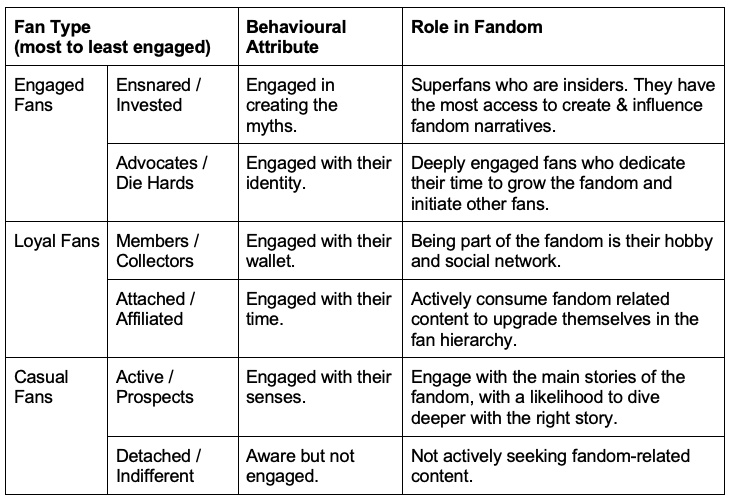This is part of an ongoing series of FreeFlowing articles penned by guest authors. Our guest author for the day is Vineet Kanabar.
Vineet Kanabar is a creator among marketers and a marketer among creators. He’s led marketing teams at Startups and MNCs, built content marketing strategies & capabilities and delivered 100s of millions of views across branded and editorial content. Vineet hosts the business of entertainment podcast, Story Tellers & Story Sellers. Currently, he is the Content Marketing lead at Spotify India.
Let’s see what he has to say about marketing to fandoms.
[The content below is contributed by our guest author: Vineet Kanabar. You can read more about him on his Linkedin profile here]
It’s 2022 and there’s almost zero chance of a marketing brief being written without the words “pop-culture” in it, so much so that Dr. Kotler is planning to make it the 8th P of marketing (this is a joke). As marketers get more obsessed with their brands being seen as authentic and with-it and hip to the lingo with every passing dance challenge on Reels, the view of the consumer we are addressing has evolved. From dealing with customers, or consumers, we’re now focused on attracting the attention of fans & fandoms, sometimes even without realizing it.
What are Fandoms?
Fandoms, as the name suggests, are groups of people, online & offline, who share a passion and are fans of an artist, performer, team, brand or a series. Communities of fans = a Fandom.
Any cultural artifact with enough dedicated fans can accrue a fandom – examples include music fandoms like K-Pop fans who are obsessed with the Korean wave of pop music, and allied content (see also Swifties for Taylor Swift, or Beyhive for Beyonce), or Sneakerheads who are clued into sneaker culture, tracking every drop and driving up demand. There are the Potterheads, and the Tolkien-verse fans, and those delving deep into the ever expanding mythology of Star Wars.

Closer to home, in India, we have the three Khans with their legendary fandoms perpetually engaged in one-upmanship on social media, or the legion that is dedicated to the worship of the one and only Rajnikanth. Rajnikanth’s fandom has spread far and wide, with dedicated followers even in Japan. With the explosion in creator culture, there is an emerging fandom for each major creator across platforms – from Tanmay Bhat, Bhuvan Bam & CarryMinati with legions of young male fans across India’s big & small towns, to those in kitchens across the country who swear by Madhura or Kabita or other emerging cooking creators.

Fan communities surround us – from large, mainstream groups of people consuming popular media, to niche collectors of merchandise and trivia, to superfans dedicated to creating fan-content around the objects of their fandoms. Through this act of creation, these communities are able to create their own language, cultural events, references and economies. A deeper understanding and appreciation for the internal cultural dialogue of these fandoms is required reading for any brand trying to make it with them. This is the ticket to pop-culture.
Why should brands engage with Fandoms?
1) Fandoms are highly targetable, providing the perfect niche at scale for brands
Fandoms are usually segregated by demographic factors – with high concentration in certain age groups, or locations. This immediately makes fandoms easily targetable with the right kind of messaging and content. This also creates the perfect storm of earned media driven curiosity – the elusive word of mouth that brands crave.
TVF’s Tripling with Tiago: A great example here is the brand web-series format that many brands have relied on to create stellar messaging & driven business results from within fandoms. In 2016, Tata Motors came out with the Tiago. While the car was loaded with features, the rub-off from the Tata Motors brand meant that 25 year old first time car buyers did not consider a TML vehicle in their top 5. Simply put, Tata Tiago was not a cool car. Yet.
Enter The Viral Fever, and with it the 20mn strong fandom for the creator brand. Tata Motors integrated the Tiago in the first season of TVF Tripling, with stellar results. The super-hit web-series helped the brand target their core demographics, who were also fans of TVF – young, tech-forward, first-jobbers who would consider buying a car in the next few years. The show reflected TVF’s cool positioning on to the Tiago, lifting consideration for the car by 37% and purchase intent by 19% in HSM markets. By the end of the year, Tata Tiago had broken into the top 10 passenger vehicles by sales numbers.
2) Fandoms are loyal – if you take care of the fans, they take care of your brand
The collective influence of fandoms far outweighs anything that brands can do via advertising. Being essentially collective in nature, fandoms act out of loyalty and this can tip the scales in the favour of brands when done right. KPop fandoms are known to be remarkably loyal – affecting everything from #BlackLivesMatter to stopping a Trump Rally.
One of the most exciting brand ripples came from Rick and Morty fans for McDonald’s. The show featured a sauce that McDonald’s had discontinued in 1998. On the release of the episode in 2020, fans demanded that McDonald’s bring back the Schezwan sauce, proceeding to buy it up in minutes.
Recently, Amazon has gone the fandom loyalty building route for the launch of the Lord of the Rings: Rings of Power series. The following video traces the journey of a fan, from reading the first pages of the epic fantasy legendarium, to finding his own people by way of fandom. Amazon appears 5 times in the film, as the enabler of these fandoms, speaking to the loyalty of fans.
3) Shaping culture with fandoms humanizes brands in a way advertising just can’t
In 2022, it is not a mystery that brands are run by people, for people. Fandoms provide the context and a thriving ground that gives brands the opportunity to be human, to communicate with realness & authenticity and to participate in what is of shared importance: fan culture. Engaging with fandoms provides a brand the unique opportunity to extend the brand’s universe into those of fandoms. And that leads to creating fans of the brand itself!
It’s also important to establish the relationship between investing in this effort and ensuring that the brand’s business goals reflect in the engagement. A variety of brands have attempted this but very few have really cracked the code of how to do this with remarkable consistency. Zomato is an outlier in India with a strong case for being in most fandoms – from cricket, to food, to festivals, to music and movies and beyond [read more about Zomato’s brilliant content game here]. Zomato’s need to be top of mind feeds well into their fandom engagement strategy – they have three daily opportunities to transact: breakfast, lunch and dinner – and even an owned tweet or piece of social content playing up to several overlapping active fandoms can trigger these transactions.
WOW! How do brands approach marketing to fandoms?
In their collective efforts to shape their own identity around the fan cultures they subscribe to, constituent fans seek merchandise, access or content about their fandoms. Brands must project the appropriate messaging while providing their fandoms with merchandise (identity), access (insider info) or content (entertainment).
To ascertain which kind of tactics to adopt, a great tool is the fan engagement ladder, with a doff of the hat to Roger Hart’s Ladder of Children’s Participation. The fan engagement ladder is a framework of fan attitudes and behaviours based on their level of participation in the fandom. The fan engagement ladder provides a shorthand to building strategies for marketing to fandoms. The ladder uncovers the building blocks of the fan eco-system – to identify advocates, artifacts, trends and content that matter to fandoms relevant to the brand.

Using the fandom ladder, brands can better define their engagement with a fandom. Seeing a rise in K-Pop fans among your target audience, perhaps your brand can ride the wave and create content that brings the fandom to more of your consumers. Research showing that your target audience comprises of a increasing number of European football fans – perhaps a long-term partnership with a relevant sports fandom is to be considered to deepen the brand love and drive repeat purchase from your core audience.
The word “shibboleth” means a distinguishing custom or belief that sets a particular culture apart from others. The word is biblical, and comes from the story of a war between the Ephraimites & the Gileadites. The Ephraimites had invaded Gilead, but the Gileadites had cut off their invaders route back home. When the Ephraimite army sought to cross the Jordan river, the Gileadite sentries asked each soldier to pronounce the word “shibboleth”. The Ephraimites couldn’t very well pronounce the “sh” sound so it sounded like “sibboleth” – a dead giveaway that the soldier was from the aggressor army – they were swiftly rounded up and executed.
This macabre history lesson is a great example of how cultures build codes to keep outsiders out. Fandoms with their internal lingo, logics and collectivism may seem like a daunting prospect when it comes to marketing to them. Projecting “being an insider” is a motif that brands aspire to. Luckily, fandoms are not amorphous monoliths and studies about fan cultures have given us this remarkable framework that is a great tool for brands seeking inroads into any fandom.
Recommended Content
1) Being Bhaijaan: Exploring masculinity through small town men and their love for Salman Khan. Screened at Bangalore, Delhi, Kathmandu, Mumbai, New York and Prague, among others. https://www.youtube.com/watch?v=GsKMcPPMk9Q
2) Story Tellers Story Sellers – TechnoGamerz on growing his game-streaming fandom
https://open.spotify.com/episode/1qGjQv4FjZlbBbGZdjkJ1M?si=f071162161e540b4
3) Superstar Rajinikanth’s Japanese Superfan: Yasuda Hidetoshi’s tryst with Rajinikanth’s movies also began with Muthu, released in Japan as Muthu-The Dancing Maharaja. Yasuda is one of Rajinikanth’s biggest fans; running a Japanese fan site dedicated to the superstar, travelling to Chennai for the release of every new Rajinikanth movie, organising events that celebrate the superstar’s birthday and new movie release in Japan with other fans.
https://www.youtube.com/watch?v=GrlDaDDKPrI
4) ESPN & The Revolution of Sports Marketing – The Young Influentials
https://open.spotify.com/episode/0Kqd9e1xZGLr44SLVKgr52?si=99dd90801d8d4536
